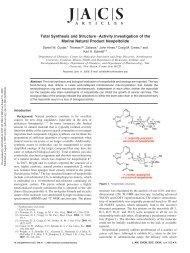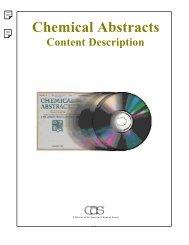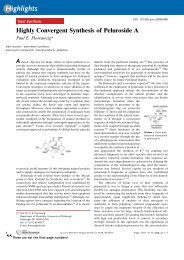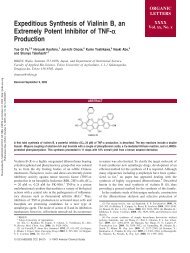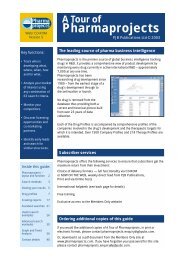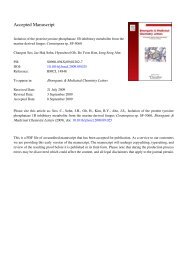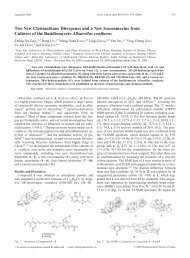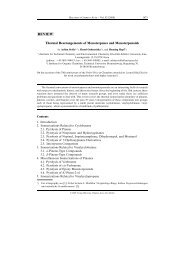Synthesis of Fluorinated Brassinosteroids Based on Alkene Cross ...
Synthesis of Fluorinated Brassinosteroids Based on Alkene Cross ...
Synthesis of Fluorinated Brassinosteroids Based on Alkene Cross ...
Create successful ePaper yourself
Turn your PDF publications into a flip-book with our unique Google optimized e-Paper software.
Downloaded by SHANGHAI INST OF ORG CHEM <strong>on</strong> September 7, 2009 | http://pubs.acs.org<br />
Publicati<strong>on</strong> Date (Web): August 31, 2009 | doi: 10.1021/jm900495f<br />
<str<strong>on</strong>g>Synthesis</str<strong>on</strong>g> <str<strong>on</strong>g>of</str<strong>on</strong>g> <str<strong>on</strong>g>Fluorinated</str<strong>on</strong>g> <str<strong>on</strong>g>Brassinosteroids</str<strong>on</strong>g> <str<strong>on</strong>g>Based</str<strong>on</strong>g> <strong>on</strong> <strong>Alkene</strong> <strong>Cross</strong>-Metathesis and<br />
Preliminary Biological Assessment<br />
r XXXX American Chemical Society<br />
J. Med. Chem. XXXX, XXX, 000–000 A<br />
DOI: 10.1021/jm900495f<br />
Barbara Eignerova, †,‡ Barbora Slavı´kova, ‡ Milos Budesı´nsky, ‡ Martin Dracı´nsky, ‡ Blanka Klepetarova, ‡ Eva St’astna, ‡ and<br />
Martin Kotora* ,†,‡<br />
† Department <str<strong>on</strong>g>of</str<strong>on</strong>g> Organic and Nuclear Chemistry, Faculty <str<strong>on</strong>g>of</str<strong>on</strong>g> Science, Charles University in Prague, Hlavova 8, 128 43 Prague 2, Czech Republic,<br />
and ‡ Institute <str<strong>on</strong>g>of</str<strong>on</strong>g> Organic Chemistry and Biochemistry AS CR, Flemingovo nam. 2, 166 10 Prague 6, Czech Republic<br />
Received April 20, 2009<br />
Three types <str<strong>on</strong>g>of</str<strong>on</strong>g> brassinosteroid analogues with perfluoroalkylated side chains were synthesized by using<br />
alkene cross-metathesis <str<strong>on</strong>g>of</str<strong>on</strong>g> a brassinosteroid derivative bearing a terminal alkene moiety with different<br />
(perfluoroalkyl)propenes. The presence <str<strong>on</strong>g>of</str<strong>on</strong>g> the double b<strong>on</strong>ds in the cross-metathesis products allowed a facile<br />
<strong>on</strong>e-step double dihydroxylati<strong>on</strong> to provide intermediates that after Baeyer-Villiger oxidati<strong>on</strong> afforded the<br />
target compounds. Biological activity <str<strong>on</strong>g>of</str<strong>on</strong>g> the prepared analogues was tested in GABA A receptor, cytotoxic,<br />
and brassinolide activity, which reached in some cases the same range as their n<strong>on</strong>fluorinated analogues.<br />
Introducti<strong>on</strong><br />
Fluorine-c<strong>on</strong>taining compounds have been an ever increasing<br />
target <str<strong>on</strong>g>of</str<strong>on</strong>g> the pharmaceutical and specialty chemicals<br />
industry. 1-3 This stems from the fact that the presence <str<strong>on</strong>g>of</str<strong>on</strong>g><br />
fluorine or fluorinated functi<strong>on</strong>al groups with their unique<br />
properties gives the target molecules special (desirable) properties<br />
(e.g., metabolic stability, increased lipophilicity, etc.). 4<br />
<str<strong>on</strong>g>Brassinosteroids</str<strong>on</strong>g> are an important class <str<strong>on</strong>g>of</str<strong>on</strong>g> plant horm<strong>on</strong>e with<br />
many potential applicati<strong>on</strong>s in agrochemistry due to their<br />
ability to stimulate growth <str<strong>on</strong>g>of</str<strong>on</strong>g> plants under undesirable c<strong>on</strong>diti<strong>on</strong>s.<br />
5,6 In additi<strong>on</strong>, some exerted unexpected antiviral and<br />
cancerostatic activity. 7-10 However, they are easily inactivated,<br />
am<strong>on</strong>g other reacti<strong>on</strong>s, by the c<strong>on</strong>versi<strong>on</strong> to more<br />
hydroxylated derivatives. 11 The site <str<strong>on</strong>g>of</str<strong>on</strong>g> such a hydroxylati<strong>on</strong><br />
has been found in the side chain, e.g., in positi<strong>on</strong> 26. Several<br />
papers describe metabolic accumulati<strong>on</strong> <str<strong>on</strong>g>of</str<strong>on</strong>g> C-26-, C-28-hydroxylated,<br />
or further oxidized products. Because the metabolic<br />
stability <str<strong>on</strong>g>of</str<strong>on</strong>g> the C-F b<strong>on</strong>d is very high, fluorinec<strong>on</strong>taining<br />
brassinosteroids would have practical significance<br />
because <str<strong>on</strong>g>of</str<strong>on</strong>g> a good stability <str<strong>on</strong>g>of</str<strong>on</strong>g> products. This suggesti<strong>on</strong> was<br />
c<strong>on</strong>firmed by synthesis and metabolic stability studies <str<strong>on</strong>g>of</str<strong>on</strong>g> their<br />
m<strong>on</strong><str<strong>on</strong>g>of</str<strong>on</strong>g>luoroderivatives. 12 Similar results were obtained for<br />
brassinosteroids bearing perfluoroalkylated ester side chains<br />
instead <str<strong>on</strong>g>of</str<strong>on</strong>g> the classical sterol <strong>on</strong>e. They were found to possess<br />
the activity comparable to natural brassinosteroids. 13<br />
Despite c<strong>on</strong>siderable advances in perfluoroalkylati<strong>on</strong> methodology,<br />
14-16 the search for new more synthetically flexible procedures<br />
is highly desirable. One such attractive process is highly<br />
selective alkene cross-metathesis under mild reacti<strong>on</strong> c<strong>on</strong>diti<strong>on</strong>s<br />
17 that has been utilized in the synthesis <str<strong>on</strong>g>of</str<strong>on</strong>g> a number <str<strong>on</strong>g>of</str<strong>on</strong>g> fluorinated<br />
compounds. 18-27 Recently, we have also reported that<br />
the perfluoroalkylati<strong>on</strong> could be achieved by cross-metathesis<br />
with perfluoroalkylpropenes 28 that showed higher reactivity,<br />
selectivity, and efficiency in comparis<strong>on</strong> with other methods.<br />
*To whom corresp<strong>on</strong>dence should be addressed. Ph<strong>on</strong>e: þ420 221<br />
951 334. Fax: þ420 221 951 326. E-mail: kotora@natur.cuni.cz. Address:<br />
Martin Kotora, Department <str<strong>on</strong>g>of</str<strong>on</strong>g> Organic and Nuclear Chemistry,<br />
Faculty <str<strong>on</strong>g>of</str<strong>on</strong>g> Science, Charles University in Prague, Hlavova 8, 128 43<br />
Prague 2, Czech Republic.<br />
In this regard, we aimed at two goals: the synthesis <str<strong>on</strong>g>of</str<strong>on</strong>g> a<br />
modified molecule and the development <str<strong>on</strong>g>of</str<strong>on</strong>g> a suitable synthetic<br />
methodology. As for the former, the synthesis <str<strong>on</strong>g>of</str<strong>on</strong>g> brassinosteroids<br />
bearing fluorinated side chains such as 1a-1c (Figure 1)<br />
was expected to afford a new type <str<strong>on</strong>g>of</str<strong>on</strong>g> brassinosteroid derivatives<br />
resistant to the above-menti<strong>on</strong>ed undesirable side reacti<strong>on</strong><br />
with increased metabolic stability, 4,12,13 and perhaps<br />
better biological activity. As for the latter, to dem<strong>on</strong>strate<br />
that cross-metathesis <str<strong>on</strong>g>of</str<strong>on</strong>g> terminal alkenes with perfluoroalkylpropenes<br />
is a c<strong>on</strong>venient method for synthesis <str<strong>on</strong>g>of</str<strong>on</strong>g> brassinosteroids<br />
bearing perfluoroalkylated side chains.<br />
Results and Discussi<strong>on</strong><br />
<str<strong>on</strong>g>Synthesis</str<strong>on</strong>g>. The underlying strategy was based <strong>on</strong> the<br />
following assumpti<strong>on</strong>: because the brassinolide side chain<br />
c<strong>on</strong>tains a 1,2-diol moiety, it could be c<strong>on</strong>veniently prepared<br />
by dihydroxylati<strong>on</strong> <str<strong>on</strong>g>of</str<strong>on</strong>g> a suitable unsaturated intermediate,<br />
which in turn could be prepared by cross-metathesis <str<strong>on</strong>g>of</str<strong>on</strong>g> a<br />
terminal alkene with the appropriately substituted perfluoroalkylpropene<br />
(Scheme 1).<br />
The starting substrate 3 was prepared by standard synthetic<br />
methodology in six steps from commercially available<br />
carboxylic acid 2 (Scheme 2). 29 Ester 3 was then reduced by<br />
LiAlH4 to alcohol 4 (88%), which was oxidized by using<br />
Dess-Martin reagent to aldehyde 5 (76%), 30 whose Wittig<br />
olefinati<strong>on</strong> afforded alkene 6 (93%). 31 Deprotecti<strong>on</strong> <str<strong>on</strong>g>of</str<strong>on</strong>g> its<br />
carb<strong>on</strong>yl group under acidic c<strong>on</strong>diti<strong>on</strong>s afforded the required<br />
alkene 7 in good 96% isolated yield. With the alkene<br />
7 <strong>on</strong> hand, cross-metatheses with perfluorohexyl- 8a, perfluoropropyl-<br />
8b, and perfluoroisopropylpropene 8c (2-fold<br />
molar excess) were carried out. On the basis <str<strong>on</strong>g>of</str<strong>on</strong>g> previous<br />
results, the reacti<strong>on</strong> was catalyzed by Hoveyda-Grubbs<br />
sec<strong>on</strong>d-generati<strong>on</strong> catalyst 32,33 (10 mol %) in refluxing<br />
dichloromethane for 4 h. 28 In all cases the cross-metathesis<br />
proceeded smoothly to give the corresp<strong>on</strong>ding perfluoroalkylated<br />
products 9a-9c in good 67, 71, and 59% isolated<br />
yields, respectively. According to NMR analysis, compounds<br />
9a and 9b were obtained as pure trans double-b<strong>on</strong>d<br />
isomers; <strong>on</strong>ly in the case <str<strong>on</strong>g>of</str<strong>on</strong>g> 9c a 19/1 trans/cis mixture was<br />
pubs.acs.org/jmc
Downloaded by SHANGHAI INST OF ORG CHEM <strong>on</strong> September 7, 2009 | http://pubs.acs.org<br />
Publicati<strong>on</strong> Date (Web): August 31, 2009 | doi: 10.1021/jm900495f<br />
B Journal <str<strong>on</strong>g>of</str<strong>on</strong>g> Medicinal Chemistry, XXXX, Vol. XXX, No. XX Eignerova et al.<br />
obtained. The structure <str<strong>on</strong>g>of</str<strong>on</strong>g> trans-9c was unequivocally c<strong>on</strong>firmed<br />
by a single crystal X-ray analysis.<br />
Because compounds 9a-9c possess two double b<strong>on</strong>ds<br />
within the molecule, simultaneous dihydroxylati<strong>on</strong> was attempted.<br />
The hydroxylati<strong>on</strong> <str<strong>on</strong>g>of</str<strong>on</strong>g> the double b<strong>on</strong>ds was carried<br />
out by catalytic amount <str<strong>on</strong>g>of</str<strong>on</strong>g> OsO 4 (15 mol %) and excess<br />
N-methyl morpholine N-oxide (3.5 fold excess). 13 Initial<br />
hydroxylati<strong>on</strong> <str<strong>on</strong>g>of</str<strong>on</strong>g> 9a for 2 h led <strong>on</strong>ly to a 1/1.5 mixture <str<strong>on</strong>g>of</str<strong>on</strong>g><br />
10a and 11a in 50% isolated yield. The previous findings<br />
clearly dem<strong>on</strong>strated that dihydroxylati<strong>on</strong> takes place preferentially<br />
<strong>on</strong> the more electr<strong>on</strong>-rich double b<strong>on</strong>d in the<br />
cyclohexane ring. To achieve full c<strong>on</strong>versi<strong>on</strong>, the hydroxylati<strong>on</strong><br />
time was prol<strong>on</strong>ged to 16 h. Under these c<strong>on</strong>diti<strong>on</strong>s,<br />
9a-9c were fully c<strong>on</strong>verted to tetraols 11a-11c that were<br />
isolated as single diastereoisomers in good isolated yields <str<strong>on</strong>g>of</str<strong>on</strong>g><br />
68, 50, and 46%, respectively. The observed dihydroxylati<strong>on</strong><br />
diastereoselectivity could be explained as follows: in case <str<strong>on</strong>g>of</str<strong>on</strong>g><br />
Figure 1. <str<strong>on</strong>g>Brassinosteroids</str<strong>on</strong>g> 1a-1c with perfluoroalkylated side chain.<br />
Scheme 1. C<strong>on</strong>structi<strong>on</strong> <str<strong>on</strong>g>of</str<strong>on</strong>g> Perfluoroalkylated 28-Norbrassinosteroid<br />
Side Chain<br />
Scheme 2. <str<strong>on</strong>g>Synthesis</str<strong>on</strong>g> <str<strong>on</strong>g>of</str<strong>on</strong>g> <str<strong>on</strong>g>Brassinosteroids</str<strong>on</strong>g> with Perfluoroalkylated Side Chains<br />
the cyclohexene ring, an oxidizing agent is approaching the<br />
double b<strong>on</strong>d from the less hindered side, i.e., from the<br />
bottom side <str<strong>on</strong>g>of</str<strong>on</strong>g> the molecule, and in the case <str<strong>on</strong>g>of</str<strong>on</strong>g> the side chain<br />
double b<strong>on</strong>d it is c<strong>on</strong>trolled by the presence <str<strong>on</strong>g>of</str<strong>on</strong>g> the center <str<strong>on</strong>g>of</str<strong>on</strong>g><br />
chirality <strong>on</strong> C-20. Although the formati<strong>on</strong> <str<strong>on</strong>g>of</str<strong>on</strong>g> other possible<br />
diastereoisomers can not be excluded, they were not detected<br />
in the reacti<strong>on</strong> mixture.<br />
Finally, the synthesis was completed by Baeyer-Villiger<br />
oxidati<strong>on</strong> <str<strong>on</strong>g>of</str<strong>on</strong>g> 11a-11c by trifluoroperacetic acid (prepared by<br />
mixing trifluoroacetic anhydride and hydrogen peroxide in<br />
dichloromethane) under ambient c<strong>on</strong>diti<strong>on</strong>s. In each case,<br />
the oxidati<strong>on</strong> afforded a mixture <str<strong>on</strong>g>of</str<strong>on</strong>g> two regioisomeric lact<strong>on</strong>es<br />
in 4:1 ratio in favor <str<strong>on</strong>g>of</str<strong>on</strong>g> the desired regioisomers 1a-1c<br />
with natural c<strong>on</strong>figurati<strong>on</strong> <str<strong>on</strong>g>of</str<strong>on</strong>g> diol moiety in the side chain.<br />
The desired brassinosteroids 1a-1c were isolated by preparative<br />
HPLC in 62, 70, and 61% yields, respectively.<br />
Biology. Because the brassinosteroids are known to possess<br />
various biological activities, the newly attained compounds,<br />
1a-1c and 11a-11c, c<strong>on</strong>stituted ideal substrates for testing in<br />
various assays because <str<strong>on</strong>g>of</str<strong>on</strong>g> their new structural and previously<br />
unexplored feature, a perfluoroalkylated side chain.<br />
GABA A Receptors Activity. Initially, the binding <str<strong>on</strong>g>of</str<strong>on</strong>g> the<br />
compounds 1a-1c to GABA A receptors was tested in vitro<br />
using membranes isolated from the brains <str<strong>on</strong>g>of</str<strong>on</strong>g> male Wistar<br />
rats. The specific steroid binding was detected by the decrease<br />
in the binding <str<strong>on</strong>g>of</str<strong>on</strong>g> 2 nM [ 35 S]-tert-butylbicyclo-[2.2.2]<br />
phosphorothi<strong>on</strong>ate (TBPS) after applicati<strong>on</strong> <str<strong>on</strong>g>of</str<strong>on</strong>g> the tested<br />
compounds incubated for 1 h at 37 °C. The results (see<br />
Table 1) could be summarized as follows: the heptafluoro<br />
derivative 1c compares favorably to natural horm<strong>on</strong>e allopregnanol<strong>on</strong>e<br />
12 and its higher metabolic stability (with<br />
respect to potential hydroxylati<strong>on</strong> <str<strong>on</strong>g>of</str<strong>on</strong>g> the side chain) 4,12,13<br />
should more than compensate for its slightly lower GABAlike<br />
activity. The results are in agreement with structural<br />
similarity <str<strong>on</strong>g>of</str<strong>on</strong>g> 1c and 28-norbrassinolide 13 (Figure 2). 13<br />
Compound 1a, which does not c<strong>on</strong>tain the steroidal i-octyl<br />
side chain, is active at a higher c<strong>on</strong>centrati<strong>on</strong> <strong>on</strong>ly and<br />
compound 1b is inactive.
Downloaded by SHANGHAI INST OF ORG CHEM <strong>on</strong> September 7, 2009 | http://pubs.acs.org<br />
Publicati<strong>on</strong> Date (Web): August 31, 2009 | doi: 10.1021/jm900495f<br />
Brief Article Journal <str<strong>on</strong>g>of</str<strong>on</strong>g> Medicinal Chemistry, XXXX, Vol. XXX, No. XX C<br />
Table 1. Modulatory Effect <strong>on</strong> GABAA Receptors<br />
compd [ 35 S]-TBPS (%) a<br />
Imax(%) b<br />
allopregnanol<strong>on</strong>e 12 56.2 ( 6.0* 79.0 80<br />
1a 47.2 ( 15.1* 57.9 900<br />
1b 95.1 ( 14.8<br />
d d<br />
1c 56.6 ( 14.6* 59.4 100<br />
IC 50 (nM) c<br />
a The values <str<strong>on</strong>g>of</str<strong>on</strong>g> samples c<strong>on</strong>taining tested compounds at 100 nM<br />
c<strong>on</strong>centrati<strong>on</strong>s were related to these <str<strong>on</strong>g>of</str<strong>on</strong>g> c<strong>on</strong>trol samples with the buffer<br />
and expressed in %. Data are presented as means ( SD (obtained from<br />
triplicates or quadruplicates). To estimate statistical significance, n<strong>on</strong>parametric<br />
Kruskal-Wallis test for a global comparis<strong>on</strong> (χ 2 (4)=13.95,<br />
p=0.0074) and Mann-Whitney-Wilcox<strong>on</strong> test for pairwise comparis<strong>on</strong>s<br />
(it was calculated with respect to the c<strong>on</strong>trol samples, *p < 0.050).<br />
b The maximal suppressi<strong>on</strong> <str<strong>on</strong>g>of</str<strong>on</strong>g> the binding. c the steroid c<strong>on</strong>centrati<strong>on</strong><br />
producing a half-maximal inhibiti<strong>on</strong> were estimated using 1 nM TO<br />
10 μM c<strong>on</strong>centrati<strong>on</strong>s (in duplicates) <str<strong>on</strong>g>of</str<strong>on</strong>g> compounds. d Not determined.<br />
Figure 2. Structures <str<strong>on</strong>g>of</str<strong>on</strong>g> allopregnanol<strong>on</strong>e 12, 28-norbrassinolide<br />
13, 28-homocastaster<strong>on</strong>e 14, and 24-epibrassinolide 15.<br />
Anticancer Activity. <str<strong>on</strong>g>Brassinosteroids</str<strong>on</strong>g> are also known to<br />
exhibit anticancer activity. 7,8,10 The cytotoxic activity <str<strong>on</strong>g>of</str<strong>on</strong>g><br />
1a-1c was determined by comparing human normal<br />
(fibroblast BJ) and cancer cell lines (T-lymphoblastic leukemia<br />
CEM and breast carcinoma MCF 7). These were<br />
exposed to six serial 4-fold diluti<strong>on</strong>s <str<strong>on</strong>g>of</str<strong>on</strong>g> each drug for 72 h,<br />
the proporti<strong>on</strong>s <str<strong>on</strong>g>of</str<strong>on</strong>g> surviving cells were then estimated, and<br />
IC 50 values were calculated (28-homocastaster<strong>on</strong>e was used<br />
as a positive c<strong>on</strong>trol). Unfortunately, <strong>on</strong>ly 11b exhibited<br />
slight activity against CEM cell line (IC 50 = 35.3 μM)<br />
(see Table 2). The other tested compounds such as 1a-1c,<br />
11a, and 11c had extremely weak or no detectable activity<br />
(IC 50 >50μM). However, it is important to emphasize that<br />
tested compounds are not toxic toward normal human cells<br />
at all.<br />
Brassinolide-Type Activity. Last but not least, brassinolide<br />
activity was measured by the bean sec<strong>on</strong>d-internode bioassay.<br />
13,34 The length <str<strong>on</strong>g>of</str<strong>on</strong>g> the sec<strong>on</strong>d internodes was measured 5<br />
days after the applicati<strong>on</strong> <str<strong>on</strong>g>of</str<strong>on</strong>g> tested compounds in lanoline<br />
and the difference in length between treated and c<strong>on</strong>trol<br />
plants provided a measure <str<strong>on</strong>g>of</str<strong>on</strong>g> activity (see Table 3). It was<br />
found that compound 1b exhibited expressive swelling <str<strong>on</strong>g>of</str<strong>on</strong>g> the<br />
sec<strong>on</strong>d bean internode at c<strong>on</strong>centrati<strong>on</strong> 10 -7 mol 3 L -1 .<br />
Moreover, compound 1c exhibited surprising activity at<br />
lower and higher c<strong>on</strong>centrati<strong>on</strong>s differing by 5 orders (10 -7<br />
and 10 -12 mol 3 L -1 , þ15.9 and þ10.7 mm, respectively).<br />
C<strong>on</strong>clusi<strong>on</strong><br />
The synthetic route based <strong>on</strong> the cross-metathesis between<br />
terminal alkenes and perfluoroalkylpropenes c<strong>on</strong>stitutes an<br />
Table 2. Cytotoxic Activity (IC50) <str<strong>on</strong>g>of</str<strong>on</strong>g> <str<strong>on</strong>g>Brassinosteroids</str<strong>on</strong>g> Determined by<br />
Calcein-AM Assays a<br />
compd CEM b (μM) MCF 7 c (μM)<br />
28-homocastaster<strong>on</strong>e 14 13 ( 2.8 >50<br />
1a >50 >50<br />
1b >50 >50<br />
1c >50 >50<br />
11a >50 >50<br />
11b 35.3 ( 1.6 48.2 ( 0.6<br />
11c >50 >50<br />
a The IC50 values are expressed as mean ( SD values <str<strong>on</strong>g>of</str<strong>on</strong>g> three<br />
independent experiments performed in triplicate. b T-lymphoblastic<br />
leukemia cell line CEM. c Breast carcinoma cell lines MCF-7.<br />
Table 3. Activity in the Bean Sec<strong>on</strong>d-Internode Bioassay<br />
compd PSI a<br />
SD<br />
24-epibrassinolide 15 32.3 (5.7<br />
1a 3.1 (1.1<br />
1b 11.0 (3.7<br />
1c 0.9 (0.3<br />
11a 14.1 (4.1<br />
11b 9.6 (3.1<br />
11c 11.6 (4.9<br />
a PSI: Difference <str<strong>on</strong>g>of</str<strong>on</strong>g> prol<strong>on</strong>gati<strong>on</strong> <str<strong>on</strong>g>of</str<strong>on</strong>g> the Sec<strong>on</strong>d Internode SD (mm) at<br />
c<strong>on</strong>centrati<strong>on</strong> 10 -10 mol 3 L -1 to c<strong>on</strong>trol.<br />
easy access to a new type <str<strong>on</strong>g>of</str<strong>on</strong>g> brassinosteroids with perfluoroalkylated<br />
side chains. The flexibility <str<strong>on</strong>g>of</str<strong>on</strong>g> our approach permits,<br />
in principle, introducti<strong>on</strong> <str<strong>on</strong>g>of</str<strong>on</strong>g> any kind <str<strong>on</strong>g>of</str<strong>on</strong>g> side chains not<br />
<strong>on</strong>ly <strong>on</strong> the brassinosteroid but also other frameworks and<br />
provides a powerful tool for an analogue development and for<br />
an elucidati<strong>on</strong> <str<strong>on</strong>g>of</str<strong>on</strong>g> biological functi<strong>on</strong>s.<br />
The preliminary biological testing showed that some <str<strong>on</strong>g>of</str<strong>on</strong>g> the<br />
prepared brassinosteroids with fluorinated side chain exhibit<br />
the GABA A activity comparable with the endogeneous neurosteroid<br />
allopregnanol<strong>on</strong>e. On the other hand, the anticancer<br />
activity was insignificant. Furthermore, the results <str<strong>on</strong>g>of</str<strong>on</strong>g> the<br />
brassinolide activity <str<strong>on</strong>g>of</str<strong>on</strong>g> the prepared perfluoroalkylated<br />
compounds were in the range <str<strong>on</strong>g>of</str<strong>on</strong>g> previously tested n<strong>on</strong>fluorinated<br />
analogues. These studies thus open not <strong>on</strong>ly new<br />
possibilities for the synthesis new functi<strong>on</strong>alized brassinosteroid<br />
analogues but also could serve as a general strategy for the<br />
preparati<strong>on</strong> <str<strong>on</strong>g>of</str<strong>on</strong>g> other classes <str<strong>on</strong>g>of</str<strong>on</strong>g> compounds bearing perfluorinated<br />
side chain.<br />
Experimental Secti<strong>on</strong><br />
General. All solvents were used as obtained unless otherwise<br />
noted. THF was distilled from sodium and benzophen<strong>on</strong>e.<br />
Perfluoroalkylated propenes 8a, 8b, and 8c (spectral characteristics<br />
were in agreement with the previously reported data) 35-37<br />
were prepared according to the previously reported procedure. 38<br />
All other reagents were obtained from commercial sources. The<br />
NMR spectra were measured <strong>on</strong> Bruker AVANCE 500 and 600<br />
instruments ( 1 H at 500 or 600 MHz, 13 C at 125.7 or 150.9 MHz,<br />
and 19 F NMR at 470.3 MHz) as soluti<strong>on</strong>s in CDCl3 at 27 °C<br />
unless otherwise noted. Chemical shifts are given in δ scale ( 1 H<br />
NMR spectra were referenced to TMS as an internal standard,<br />
13<br />
C NMR spectra to CDCl3 at δ 77.0, and 19 F NMR to C6F6<br />
δ -163.0), coupling c<strong>on</strong>stants J are given in Hz. Melting points<br />
(uncorrected) were determined using a K<str<strong>on</strong>g>of</str<strong>on</strong>g>ler apparatus. Infrared<br />
spectra were recorded as CHCl3 soluti<strong>on</strong>s or as KBr tablets<br />
and are reported in wave numbers (cm -1 ). The HPLC system<br />
used c<strong>on</strong>sisted <str<strong>on</strong>g>of</str<strong>on</strong>g> a high pressure pump (model 361, Gils<strong>on</strong>),<br />
Rheodyne valve, preparative column (10 mm 250 mm) with<br />
silica gel filling (Biosher PSI 200 7micro-m, Labio), preparative<br />
ELSD detector (Gils<strong>on</strong>) c<strong>on</strong>nected with PC (s<str<strong>on</strong>g>of</str<strong>on</strong>g>tware Triluti<strong>on</strong>
Downloaded by SHANGHAI INST OF ORG CHEM <strong>on</strong> September 7, 2009 | http://pubs.acs.org<br />
Publicati<strong>on</strong> Date (Web): August 31, 2009 | doi: 10.1021/jm900495f<br />
D Journal <str<strong>on</strong>g>of</str<strong>on</strong>g> Medicinal Chemistry, XXXX, Vol. XXX, No. XX Eignerova et al.<br />
LC, Gils<strong>on</strong>), and automatic fracti<strong>on</strong> collector (model 346, Gils<strong>on</strong>).<br />
Purity <str<strong>on</strong>g>of</str<strong>on</strong>g> the prepared compounds was determined by a combinati<strong>on</strong><br />
<str<strong>on</strong>g>of</str<strong>on</strong>g> 1 H NMR and by HLPC techniques and was >95%.<br />
General Procedure for <strong>Cross</strong>-Metathesis <str<strong>on</strong>g>of</str<strong>on</strong>g> 7 with (Perfluoroalkyl)propenes<br />
8. Toamixture<str<strong>on</strong>g>of</str<strong>on</strong>g>aterminalalkene7 (1 mmol) and<br />
(perfluoroalkyl)propenes 8a-8c (2 mmol) in CH 2Cl 2 (8 mL) under<br />
Ar atmosphere was added Hoveyda-Grubbs sec<strong>on</strong>d-generati<strong>on</strong><br />
catalyst (63 mg, 0.1 mmol) and it was stirred at 42 °C for 4 h. Evaporati<strong>on</strong><br />
<str<strong>on</strong>g>of</str<strong>on</strong>g> the volatiles under reduced pressure followed by column<br />
chromatography <strong>on</strong> silica gel afforded expected compounds.<br />
(20S)-20-(4 0 ,4 0 ,5 0 ,5 0 ,6 0 ,6 0 ,7 0 ,7 0 ,8 0 ,8 0 ,9 0 ,9 0 ,9 0 -Tridecafluor<strong>on</strong><strong>on</strong>-<br />
1 0 -en-1 0 -yl)-5r-pregn-2-en-6-<strong>on</strong>e (9a). The reacti<strong>on</strong> was carried<br />
out with 7 (250 mg, 0.77 mmol) and 8a (551 mg, 1.53 mmol)<br />
according to the general procedure. Column chromatography<br />
<strong>on</strong> silica gel (50/1 hexane/EtOAc) and crystallizati<strong>on</strong> (MeOH)<br />
yielded 338 mg (67%) <str<strong>on</strong>g>of</str<strong>on</strong>g> the title compound 9a as white<br />
needles: mp 101-102 °C (MeOH); [R]D 20 þ6.4 (c 0.22, CHCl3).<br />
1 H NMR (600 MHz, CDCl3) δ 0.70 (s, 3H), 0.72 (s, 3H), 1.05<br />
(d, J=6.6 Hz, 3H), 2.75 (m, 2H), 5.32 (dt, J=15.2, 7.2 Hz, 1H),<br />
5.55 (ddt, J = 15.3, 8.8, 1.3 Hz, 1H), 5.57 (m, 1H), 5.69 (m, 1H).<br />
HR-MS (EI) calcd. for C30H35OF13 [M þ ] 658.2480, found<br />
658.2485. Rf (20/1 hexane/EtOAc) = 0.24.<br />
(20S)-20-(4 0 ,4 0 ,5 0 ,5 0 ,6 0 ,6 0 ,6 0 -Heptafluorohex-1 0 -en-1 0 -yl)-5rpregn-2-en-6-<strong>on</strong>e<br />
(9b). The reacti<strong>on</strong> was carried out with 7<br />
(360 mg, 1.1 mmol) and 8b (463 mg, 2.2 mmol) according to<br />
the general procedure. Column chromatography <strong>on</strong> silica gel<br />
(50/1 hexane/EtOAc) and crystallizati<strong>on</strong> (MeOH) yielded 397<br />
mg (71%) <str<strong>on</strong>g>of</str<strong>on</strong>g> the title compound 9b as white crystals: mp<br />
117-119 °C (MeOH); [R]D 20 þ12.9 (c 0.20, CHCl3). 1 HNMR<br />
(600 MHz, CDCl 3) δ 0.70 (s, 3H), 0.72 (s, 3H), 1.05 (d, J=6.6<br />
Hz, 3H), 2.75 (m, 2H), 5.32 (dt, J=15.3, 7.1 Hz, 1H), 5.55 (ddt,<br />
J=15.3, 8.8, 1.2 Hz, 1H), 5.57 (m, 1H), 5.69 (m, 1H). HR-MS<br />
(ESI) calcd. for C27H36OF7 [M þ þ 1] 509.2649, found<br />
509.2650. Rf (20/1 hexane/EtOAc)=0.24.<br />
22-(E)-(20S)-25,26,26,26,27,27,27-Heptafluoro-cholesta-2,22dien-6-<strong>on</strong>e<br />
(9c). The reacti<strong>on</strong> was carried out with 7 (340 mg, 1.04<br />
mmol) and 8c (440 mg, 2.0 mmol) according to the general<br />
procedure. Column chromatography <strong>on</strong> silica gel (50/1 hexane/<br />
EtOAc) and crystallizati<strong>on</strong> (MeOH) yielded 315 mg (59%) <str<strong>on</strong>g>of</str<strong>on</strong>g> the<br />
title compound 9c as white crystals: mp 125-126 °C (MeOH);<br />
[R]D 20 þ19.5 (c 0.17, CHCl3). 1 H NMR (600 MHz, CDCl3)<br />
δ 0.69 (s, 3H), 0.71 (s, 3H), 1.03 (d, J=6.7 Hz, 3H), 2.77 (bdd, J=<br />
20.0, 7.0 Hz, 2H), 5.30 (bdt, J=15.1, 7.0 Hz, 1H), 5.52 (bdd, J=<br />
15.1, 8.8 Hz, 1H), 5.57 (m, 1H), 5.69 (m, 1H). HR-MS (ESI)<br />
calcd for C27H36OF7 [M þ þ 1] 509.2649, found 509.2649. Rf (20/<br />
1 hexane/EtOAc)=0.24.<br />
General Procedure for Dihydroxylati<strong>on</strong>. 13 Asoluti<strong>on</strong><str<strong>on</strong>g>of</str<strong>on</strong>g>OsO 4<br />
(13 mg, 0.05 mmol) in 2-methyl-propan-2-ol (0.12 mL) was added<br />
to a soluti<strong>on</strong> <str<strong>on</strong>g>of</str<strong>on</strong>g> olefin 9 (0.35 mmol) in acet<strong>on</strong>e (8 mL) and<br />
tetrahydr<str<strong>on</strong>g>of</str<strong>on</strong>g>uran (8 mL). Next, N-methylmorpholine N-oxide<br />
(140 mg, 1.2 mmol) in water (0.2 mL) was added. The mixture<br />
was stirred under Ar atmosphere for 16 h at room temperature. A<br />
soluti<strong>on</strong> <str<strong>on</strong>g>of</str<strong>on</strong>g> sodium sulfite (5 mL, 10%) was then added and the<br />
mixture was stirred for 30 min, poured into water, and extracted<br />
with chlor<str<strong>on</strong>g>of</str<strong>on</strong>g>orm. Column chromatography <strong>on</strong> silica gel (1/2<br />
hexane/EtOAc) and crystallizati<strong>on</strong> (heptane/acet<strong>on</strong>e) yielded<br />
compounds 11a-11c as a white crystals.<br />
(20S,1 0 R,2 0 R)-2r,3r,1 0 ,2 0 -Tetrahydroxy-20-(4 0 ,4 0 ,5 0 ,5 0 ,6 0 ,6 0 ,7 0 ,<br />
7 0 ,8 0 ,8 0 ,9 0 ,9 0 ,9 0 -tridecafluor<strong>on</strong><strong>on</strong>-1 0 -yl)-5r-pregnan-6-<strong>on</strong>e (11a).<br />
The reacti<strong>on</strong> was carried out with 9a (115 mg, 0.17 mmol).<br />
Column chromatography <strong>on</strong> silica gel (1/2 hexane/EtOAc)<br />
afforded 86 mg (68%) <str<strong>on</strong>g>of</str<strong>on</strong>g> the title compound 11a as white<br />
crystals: mp 220-221 °C (acet<strong>on</strong>e/heptane); [R]D 20 -1.9<br />
(c 0.11, MeOH). 1 H NMR (600 MHz, CD 3OD) δ 0.70 (s, 3H),<br />
0.76 (s, 3H), 1.06 (d, J=6.8 Hz, 3H), 2.48 (m, 1H), 2.69 (ddd,<br />
J = 12.6, 3.4, 0.8 Hz, 1H), 3.52 (dd, J = 4.6, 1.7 Hz, 1H),<br />
3.77 (ddd, J=11.8, 4.8, 3.2 Hz, 1H), 4.06 (q, J=3.3 Hz, 1H),<br />
4.30 (ddd, J = 8.0, 3.8, 1.7 Hz, 1H). HR-MS (ESI) calcd for<br />
C30H39O5F13Na [M þ þ Na] 749.2482, found 749.2476. Rf (2/3<br />
toluene/EtOAc)=0.23.<br />
(20S,1 0 R,2 0 R)-2r,3r,1 0 ,2 0 -Tetrahydroxy-20-(4 0 ,4 0 ,5 0 ,5 0 ,6 0 ,6 0 ,6 0 -<br />
heptafluorohex-1 0 -yl)-5r-pregnan-6-<strong>on</strong>e (11b). The reacti<strong>on</strong> was<br />
carried out with 9b (190 mg, 0.37 mmol). Column chromatography<br />
<strong>on</strong> silica gel (1/2 hexane/EtOAc) afforded 107 mg (50%) <str<strong>on</strong>g>of</str<strong>on</strong>g><br />
the title compound 11b as white crystals: mp 176-178 °C<br />
(acet<strong>on</strong>e/heptane); [R]D 20 -23.9 (c 0.13, CHCl3). 1 H NMR<br />
(600 MHz, CD3OD) δ 0.75 (s, 3H), 0.77 (s, 3H), 1.10 (d, J =<br />
6.6 Hz, 3H), 2.40 (m, 2H), 2.74 (bdd, J=11.5, 3.4 Hz, 1H), 3.44<br />
(dd, J=4.9, 1.5 Hz, 1H), 3.66 (ddd, J=11.8, 4.8, 3.0 Hz, 1H), 3.95<br />
(bq, J=3.0, 1H), 4.22 (ddd, J=7.8, 3.9, 1.5 Hz, 1H). HR-MS<br />
(ESI) calcd for C27H40O5F7 [M þ þ 1] 577.2758, found 577.2759.<br />
Rf (20/1 toluene/EtOAc) = 0.23.<br />
(20S,22R,23R)-2r,3r,22,23-Tetrahydroxy-25,26,26,26,27,27,<br />
27-heptafluoro-cholestan-6-<strong>on</strong>e (11c). The reacti<strong>on</strong> was carried<br />
out with 9c (190 mg, 0.37 mmol). Column chromatography <strong>on</strong><br />
silica gel (1/2 hexane/EtOAc) afforded 98 mg (46%) <str<strong>on</strong>g>of</str<strong>on</strong>g> the title<br />
compound 11c as white crystals and 11 mg (5%) <str<strong>on</strong>g>of</str<strong>on</strong>g> the compound<br />
cis-10c as a colorless oil. 11c:mp153-154 °C (acet<strong>on</strong>e/heptane);<br />
[R]D 20 -12.0 (c 0.16, CHCl3). 1 H NMR (600 MHz, CD3OD) δ<br />
0.74 (s, 3H), 0.77 (s, 3H), 1.09 (d, J=6.6 Hz, 3H), 2.42 (m, 2H),<br />
2.74 (ddd, J=12.5, 3.4, 1.0 Hz, 1H), 3.41 (dd, J=5.0, 1.5 Hz, 1H),<br />
3.66 (ddd, J=11.8, 4.8, 3.0 Hz, 1H), 3.95 (bq, J=3.0 Hz, 1H), 4.16<br />
(bd, J=7.8 Hz, 1H). HR-MS (ESI) calcd. for C27H40O5F7 [M þ þ<br />
1] 577.2758, found 577.2759. R f (20/1 toluene/EtOAc) = 0.23.<br />
General Procedure for Baeyer-Villiger Oxidati<strong>on</strong>. 39 Asoluti<strong>on</strong><br />
<str<strong>on</strong>g>of</str<strong>on</strong>g> trifluoroperoxyacetic acid in dichloromethane (20 mL),<br />
prepared from trifluoroacetic anhydride (3.23 g, 8.24 mmol) and<br />
30% hydrogen peroxide (0.5 mL, 4.8 mmol), was added to a<br />
soluti<strong>on</strong> <str<strong>on</strong>g>of</str<strong>on</strong>g> ket<strong>on</strong>e 11 (2 mmol) in dichloromethane (16 mL) and<br />
stirred for 4 h. Then the reacti<strong>on</strong> mixture was poured into a 10%<br />
KHCO3 soluti<strong>on</strong> (200 mL), extracted with CHCl3 (3 150 mL),<br />
the combined organic extracts washed with water (200 mL), and<br />
dried over anhydrous MgSO 4. Evaporati<strong>on</strong> <str<strong>on</strong>g>of</str<strong>on</strong>g> the volatiles followed<br />
by column chromatography <strong>on</strong> silica gel (6/1 EtOAc/hexane)<br />
afforded 4/1 mixture <str<strong>on</strong>g>of</str<strong>on</strong>g> regioisomeric lact<strong>on</strong>es 11/11 0 .Further<br />
preparative HPLC (6/1 EtOAc/hexane) yielded target compounds.<br />
(20S,1 0 R,2 0 R)-2r,3r,1 0 ,2 0 -Tetrahydroxy-7-oxa-7a-homo-20-(4 0 ,<br />
4 0 ,5 0 ,5 0 ,6 0 ,6 0 ,7 0 ,7 0 ,8 0 ,8 0 ,9 0 ,9 0 ,9 0 -tridecafluor<strong>on</strong><strong>on</strong>-1 0 -yl)-5r-preg-nan-<br />
6-<strong>on</strong>e (1a). The reacti<strong>on</strong> was carried out with 11a (95 mg, 0.13<br />
mmol) and trifluoroperoxyacetic acid (2 mL). Column chromatography<br />
followed by HPLC afforded 60 mg (62%) <str<strong>on</strong>g>of</str<strong>on</strong>g> the title<br />
compound 1a as a colorless oil: [R] D 20 þ7.5 (c 0.11, CHCl3). 1 H<br />
NMR (600 MHz, CDCl 3) δ 0.73 (s, 3H), 0.92 (s, 3H), 1.05 (d, J =<br />
7.0 Hz, 3H), 2.48 (m, 1H), 3.12 (dd, J=12.3, 4.5 Hz, 1H), 3.51 (dd,<br />
J=4.7, 1.6 Hz, 1H), 3.72 (ddd, J=12.1, 4.7, 2.8 Hz,1H), 4.03 (bq,<br />
J = 3.0 Hz, 1H), 4.08 (m, 2H), 4.28 (ddd, J =7.9,3.9,1.6Hz,1H).<br />
HR-MS(ESI)calcdforC30H38O6F13 [M þ - 1] 741.2466, found<br />
741.2446. Rf (6/1 EtOAc/hexane)=0.16.<br />
(20S,1 0 R,2 0 R)-2r,3r,1 0 ,2 0 -Tetrahydroxy-7-oxa-7a-homo-20-(4 0 ,<br />
4 0 ,5 0 ,5 0 ,6 0 ,6 0 ,6 0 -heptafluorohex-1 0 -yl)-5r-pregnan-6-<strong>on</strong>e (1b). The<br />
reacti<strong>on</strong> was carried out with 11b (70 mg, 0.12 mmol) and<br />
trifluoroperoxyacetic acid (2 mL). Column chromatography followed<br />
by HPLC afforded 51 mg (70%) <str<strong>on</strong>g>of</str<strong>on</strong>g> the title compound 1b as<br />
a colorless oil: [R] D 20 þ7.0 (c 0.14, CHCl3). 1 H NMR (600 MHz,<br />
CDCl3) δ 0.73 (s, 3H), 0.92 (s, 3H), 1.05 (d, J=7.0 Hz, 3H), 2.48<br />
(m, 1H), 3.12 (dd, J=12.3, 4.5 Hz, 1H), 3.51 (dd, J=4.7, 1.6 Hz,<br />
1H), 3.72 (ddd, J=12.1, 4.7, 2.8 Hz, 1H), 4.03 (bq, J=3.0 Hz, 1H),<br />
4.08 (m, 2H), 4.28 (ddd, J=7.9, 3.9, 1.6 Hz, 1H). HR-MS (ESI)<br />
calcd for C27H38O6F7 [M þ - 1] 591.2562, found 591.2550. Rf (6/1<br />
EtOAc/hexane)=0.16.<br />
(20S,22R,23R)-2r,3r,22,23-Tetrahydroxy-7-oxa-7a-homo-<br />
25,26,26,26,27,27,27-heptafluoro-cholestan-6-<strong>on</strong>e (1c). The reacti<strong>on</strong><br />
was carried out with 11c (85 mg, 0.15 mmol) and<br />
trifluoroperoxyacetic acid (2 mL). Column chromatography<br />
followed by HPLC afforded 54 mg (62%) <str<strong>on</strong>g>of</str<strong>on</strong>g> the title compound<br />
1c as a colorless oil: [R]D 20 þ29.4 (c 0.07, MeOH).<br />
1 H NMR (600 MHz, CDCl3) δ 0.73 (s, 3H), 0.92 (s, 3H),<br />
1.04 (d, J = 7.0 Hz, 3H), 2.75 (m, 1H), 3.12 (dd, J = 12.3,<br />
4.5 Hz, 1H), 3.46 (dd, J=4.7, 1.7 Hz, 1H), 3.72 (ddd, J=12.1,<br />
4.7, 2.7 Hz, 1H), 4.03 (bq, J=3.0 Hz, 1H), 4.09 (m, 2H), 4.21
Downloaded by SHANGHAI INST OF ORG CHEM <strong>on</strong> September 7, 2009 | http://pubs.acs.org<br />
Publicati<strong>on</strong> Date (Web): August 31, 2009 | doi: 10.1021/jm900495f<br />
Brief Article Journal <str<strong>on</strong>g>of</str<strong>on</strong>g> Medicinal Chemistry, XXXX, Vol. XXX, No. XX E<br />
(m, 1H). HR-MS (ESI) calcd for C27H38O6F7 [M þ - 1]<br />
591.2562, found 591.2547. R f (6/1 EtOAc/hexane)=0.16.<br />
Biological Evaluati<strong>on</strong>. GABAA receptor binding assay, 40,41<br />
calcein-AM cytotoxicity assay, 10 and the Bean sec<strong>on</strong>d-internode<br />
bioassay 13,34 were carried out according to previously<br />
reported methods (for details, see Supporting Informati<strong>on</strong>).<br />
Acknowledgment. This work was supported by the grant<br />
project IAA400550609 and the research projects Z40550506,<br />
LC06070, LC06077, and MSM0021620857 from the Ministry<br />
<str<strong>on</strong>g>of</str<strong>on</strong>g> Educati<strong>on</strong> <str<strong>on</strong>g>of</str<strong>on</strong>g> the Czech Republic. The authors are indebted<br />
to Mgr. Oklestkova-Swaczynova (Laboratory <str<strong>on</strong>g>of</str<strong>on</strong>g> Growth<br />
Regulators, Palacky University Olomouc, Czech Republic)<br />
and Dr. Krist<str<strong>on</strong>g>of</str<strong>on</strong>g>ikova (Prague Psychiatric Centre, Prague,<br />
Czech Republic) for testing <str<strong>on</strong>g>of</str<strong>on</strong>g> the prepared compounds.<br />
Supporting Informati<strong>on</strong> Available: All experimental procedures,<br />
detailed compound characterizati<strong>on</strong> data, biological<br />
evaluati<strong>on</strong> methods, copies <str<strong>on</strong>g>of</str<strong>on</strong>g> spectra, and crystallographic<br />
informati<strong>on</strong> file. This material is available free <str<strong>on</strong>g>of</str<strong>on</strong>g> charge via<br />
the Internet at http://pubs.acs.org.<br />
References<br />
(1) Isanbor, C.; O’Hagan, D. Fluorine in medicinal chemistry: a review<br />
<str<strong>on</strong>g>of</str<strong>on</strong>g> anti-cancer agents. J. Fluorine Chem. 2006, 127, 303–319.<br />
(2) Begue, J.-P.; B<strong>on</strong>net-Delp<strong>on</strong>, D. Recent advances (1995-2005) in<br />
fluorinated pharmaceuticals based <strong>on</strong> natural products. J. Fluorine<br />
Chem. 2006, 127, 992–1012.<br />
(3) Kirk, K. L. Fluorine in medicinal chemistry: recent therapeutic<br />
applicati<strong>on</strong>s <str<strong>on</strong>g>of</str<strong>on</strong>g> fluorinated small molecules. J. Fluorine Chem.<br />
2006, 127, 1013–1029.<br />
(4) Bohm, H.-J.; Banner, D.; Bendels, S.; Kansy, M.; Kuhn, B.;<br />
Muller, K.; Obst-Sander, U.; Stahl, M. Fluorine in medicinal<br />
chemistry. ChemBioChem 2004, 5, 637–643.<br />
(5) Hayat, S.; Ahmad, A. <str<strong>on</strong>g>Brassinosteroids</str<strong>on</strong>g>. Bioactivity and Crop Productivity;<br />
Kluwer Academic Publishers: Dordrecht, The Netherlands,<br />
2003.<br />
(6) Kagale, S.; Divi, U. K.; Krochko, J. E.; Keller, W. A.; Krishna, P.<br />
Brassinosteroid c<strong>on</strong>fers tolerance in Arabidopsis thaliana and Brassica<br />
napus to a range <str<strong>on</strong>g>of</str<strong>on</strong>g> abiotic stresses. Planta 2007, 225, 353–364.<br />
(7) Swaczynova, J.; Sísa, M.; Hnilickova, J.; Kohout, L.; Strnad, M.<br />
<str<strong>on</strong>g>Synthesis</str<strong>on</strong>g>, biological, immunological, and anticancer properties <str<strong>on</strong>g>of</str<strong>on</strong>g><br />
a new brassinosteroid ligand. Pol. J. Chem. 2006, 80, 629–635.<br />
(8) Wu, Y. D.; Lou, Y. J. Brassinolide, a plant sterol from pollen <str<strong>on</strong>g>of</str<strong>on</strong>g><br />
Brassica napus L., induces apoptosis in human prostate cancer PC-<br />
3 cells. Pharmazie 2007, 62, 392–395.<br />
(9) Michelini, F. M.; Ramirez, J. A.; Berra, A.; Galagovsky, L. R.;<br />
Alche, L. E. In vitro and in vivo antiherpetic activity <str<strong>on</strong>g>of</str<strong>on</strong>g> three new<br />
synthetic brassinosteroid analogues. Steroids 2004, 69, 713–720.<br />
(10) Malikova, J.; Swaczynova, J.; Kolar, Z.; Strnad, M. Anticancer<br />
and antiproliferative activity <str<strong>on</strong>g>of</str<strong>on</strong>g> natural brassinosteroids. Phytochemistry<br />
2008, 69, 418–426.<br />
(11) Hai, T.; Schneider, B.; Adam, G. Metabolic c<strong>on</strong>versi<strong>on</strong> <str<strong>on</strong>g>of</str<strong>on</strong>g> 24-epibrassinolide<br />
into pentahydroxylated brassinosteroid glucosides in<br />
tomato cell cultures. Phytochemistry 1995, 40, 443–448.<br />
(12) Slavíkova, B.; Kohout, L.; Budesínsky, M.; Swaczynova, J.; Kasal,<br />
A. <str<strong>on</strong>g>Brassinosteroids</str<strong>on</strong>g>: synthesis and activity <str<strong>on</strong>g>of</str<strong>on</strong>g> some fluoroanalogs.<br />
J. Med. Chem. 2008, 51, 3979–3984.<br />
(13) Sísa, M.; Hnilickova, J.; Swaczynova, J.; Kohout, L. <str<strong>on</strong>g>Synthesis</str<strong>on</strong>g> <str<strong>on</strong>g>of</str<strong>on</strong>g><br />
new androstane brassinosteroids with 17beta-ester group: butyrates,<br />
heptafluorobutyrates, and laurates. Steroids 2005, 70,755–762.<br />
(14) Brace, N. O. Syntheses with perfluoroalkyl radicals from perfluoroalkyl<br />
iodides. A rapid survey <str<strong>on</strong>g>of</str<strong>on</strong>g> synthetic possibilities with<br />
emphasis <strong>on</strong> practical applicati<strong>on</strong>s. Part <strong>on</strong>e: alkenes, alkynes<br />
and allylic compounds. J. Fluorine Chem. 1999, 93, 1–25.<br />
(15) Brace, N. O. Syntheses with perfuoroalkyl iodides. Part II. Additi<strong>on</strong><br />
to n<strong>on</strong>c<strong>on</strong>jugated alkadienes; cyclizati<strong>on</strong> <str<strong>on</strong>g>of</str<strong>on</strong>g> 1,6-heptadiene,<br />
and <str<strong>on</strong>g>of</str<strong>on</strong>g> 4-substituted 1,6-heptadienoic compounds: bis-allyl ether,<br />
ethyl diallylmal<strong>on</strong>ate, N,N0-diallylamine and N-substituted diallylamines;<br />
and additi<strong>on</strong>s to homologous exo- and endo-cyclic alkenes,<br />
and to bicyclic alkenes. J. Fluorine Chem. 1999, 96, 101–127.<br />
(16) Brace, N. O. Syntheses with perfluoroalkyl iodides. A review Part<br />
III. Additi<strong>on</strong> <str<strong>on</strong>g>of</str<strong>on</strong>g> RFI to norbornene esters, acids, and anhydrides,<br />
alkenoic acids and esters, alkenylsuccinic anhydrides or diesters,<br />
and to vinyl m<strong>on</strong>omers; lact<strong>on</strong>izati<strong>on</strong> and other reacti<strong>on</strong>s <str<strong>on</strong>g>of</str<strong>on</strong>g><br />
adducts; hydroperfluoroalkylati<strong>on</strong> by RFI; synthesis and reacti<strong>on</strong>s<br />
<str<strong>on</strong>g>of</str<strong>on</strong>g> I(CF2)nI homologues (n =1-3); perfluoroalkylati<strong>on</strong> <str<strong>on</strong>g>of</str<strong>on</strong>g> arenas<br />
by RFIor[RFCO2]2;RFI in the synthesis <str<strong>on</strong>g>of</str<strong>on</strong>g> RFSR and segmented<br />
R F(CH 2) nSH; and, useful derivatives therefrom. J. Fluorine Chem.<br />
2001, 108, 147–175.<br />
(17) C<strong>on</strong>n<strong>on</strong>, S. J.; Blechert, S. Recent developments in olefin crossmetathesis.<br />
Angew. Chem., Int. Ed. 2003, 42, 1900–1923.<br />
(18) Miles, J. A. L.; Mitchell, L.; Percy, J. M.; Singh, K.; Uneyama, E.<br />
Total syntheses <str<strong>on</strong>g>of</str<strong>on</strong>g> c<strong>on</strong>formati<strong>on</strong>ally locked difluorinated pentopyranose<br />
analogues and a pentopyranosyl phosphate mimetic. J.<br />
Org. Chem. 2007, 72, 1575–1587.<br />
(19) Audouard, C.; Fawcett, J.; Griffiths, G. A.; Percy, J. M.; Pintat, S.;<br />
Smith, C. A. <str<strong>on</strong>g>Synthesis</str<strong>on</strong>g> <str<strong>on</strong>g>of</str<strong>on</strong>g> 4,4-difluoroglycosides using ring-closing<br />
metathesis. Org. Biomol. Chem. 2004, 2, 528–541.<br />
(20) Thibaudeau, S.; Fuller, R.; Gouverneur, V. Stereoselective synthesis<br />
<str<strong>on</strong>g>of</str<strong>on</strong>g> internal allyl fluorides. Org. Biomol. Chem. 2004, 2,1110–1112.<br />
(21) You, Z.-W.; Wu, Y.-Y.; Qing, F.-L. <str<strong>on</strong>g>Synthesis</str<strong>on</strong>g> <str<strong>on</strong>g>of</str<strong>on</strong>g> gem-difluoromethylated<br />
massoialact<strong>on</strong>e by ring-closing metathesis. Tetrahedr<strong>on</strong><br />
Lett. 2004, 45, 9479–9481.<br />
(22) Trnka, T. M.; Day, M. W.; Grubbs, R. H. Olefin metathesis with<br />
1,1-difluoroethylene. Angew. Chem., Int. Ed. 2001, 40, 3441–3444.<br />
(23) Marhold, M.; Buer, A.; Hiemstra, H.; van Maarseveen, J. H.;<br />
Haufe, G. <str<strong>on</strong>g>Synthesis</str<strong>on</strong>g> <str<strong>on</strong>g>of</str<strong>on</strong>g> vinyl fluorides by ring-closing metathesis.<br />
Tetrahedr<strong>on</strong> Lett. 2004, 45, 57–60.<br />
(24) De Matteis, V.; van Delft, F. L.; de Gelder, R.; Tiebes, J.; Rutjes, F.<br />
P. J. T. <str<strong>on</strong>g>Fluorinated</str<strong>on</strong>g> (hetero)cycles via ring-closing metathesis <str<strong>on</strong>g>of</str<strong>on</strong>g><br />
fluoride- and trifluoromethyl-functi<strong>on</strong>alized olefins. Tetrahedr<strong>on</strong><br />
Lett. 2004, 45, 959–963.<br />
(25) For an early example, see Chatterjee, A. K.; Morgan, J. P.; Scholl,<br />
M.; Grubbs, R. H. <str<strong>on</strong>g>Synthesis</str<strong>on</strong>g> <str<strong>on</strong>g>of</str<strong>on</strong>g> functi<strong>on</strong>alized olefins by cross and<br />
ring-closing metatheses. J. Am. Chem. Soc. 2000, 122, 3783–3784.<br />
(26) Imh<str<strong>on</strong>g>of</str<strong>on</strong>g>, S.; Randl, S.; Blechert, S. Ruthenium catalysed cross<br />
metathesis with fluorinated olefins. Chem. Commun. 2001, 1692–<br />
1693.<br />
(27) Ghera, B. B.; Facheb, F.; Parrot-Lopez, H. Use <str<strong>on</strong>g>of</str<strong>on</strong>g> the olefin<br />
metathesis reacti<strong>on</strong> for highly efficient β-cyclodextrin modificati<strong>on</strong>.<br />
Tetrahedr<strong>on</strong> 2006, 62, 4807–4813.<br />
(28) Eignerova, B.; Dracínsky, M.; Kotora, M. Perfluoroalkylati<strong>on</strong> via<br />
cross-metathesis <str<strong>on</strong>g>of</str<strong>on</strong>g> alkenes with (perfluoroalkyl)propenes. Eur. J.<br />
Org. Chem. 2008, 4493–4499.<br />
(29) For the preparati<strong>on</strong> <str<strong>on</strong>g>of</str<strong>on</strong>g> ester 3, see Kohout, L.; Chodounska,<br />
H.; Macek, M.; Strnad, M. <str<strong>on</strong>g>Synthesis</str<strong>on</strong>g> <str<strong>on</strong>g>of</str<strong>on</strong>g> (20S)-2R,3R-dihydroxy-<br />
6-oxo-7-oxa-7a-homo-5R-pregnane-20-carboxylic acid as a brassinosteroid<br />
part <str<strong>on</strong>g>of</str<strong>on</strong>g> ligands for binding to affinity chromatography<br />
carriers. Collect. Czech. Chem. Commun. 2000, 65, 1754–1761.<br />
(30) Dess, D. B.; Martin, J. C. A useful 12-I-5 triacetoxyperiodinane<br />
(the Dess-Martin periodinane) for the selective oxidati<strong>on</strong> <str<strong>on</strong>g>of</str<strong>on</strong>g><br />
primary or sec<strong>on</strong>dary alcohols and a variety <str<strong>on</strong>g>of</str<strong>on</strong>g> related 12-I-5<br />
species. J. Am. Chem. Soc. 1991, 113, 7277–7287.<br />
(31) Ikeuchi, Y.; Taguchi, T.; Hanzawa, Y. Copper-catalyzed allylati<strong>on</strong>s<br />
<str<strong>on</strong>g>of</str<strong>on</strong>g> zirc<strong>on</strong>ocene intermediates generated from o-alkenyl or<br />
o-alkynylbenzyl ether derivatives and zirc<strong>on</strong>ocene-butene complex.<br />
J. Org. Chem. 2005, 70, 756–759.<br />
(32) Garber, S. B.; Kingsbury, J. S.; Gray, B. L.; Hoveyda, A. L.<br />
Efficient and recyclable m<strong>on</strong>omeric and dendritic Ru-based metathesis<br />
catalysts. J. Am. Chem. Soc. 2000, 122, 8168–8179.<br />
(33) Gessler, S.; Randl, S.; Blechert, S. <str<strong>on</strong>g>Synthesis</str<strong>on</strong>g> and metathesis reacti<strong>on</strong>s<br />
<str<strong>on</strong>g>of</str<strong>on</strong>g> a phosphine-free dihydroimidazole carbene ruthenium<br />
complex. Tetrahedr<strong>on</strong> Lett. 2000, 41, 9973–9976.<br />
(34) Mitchell, J. W.; Livingst<strong>on</strong>e, G. A. Bean sec<strong>on</strong>d internode method.<br />
In Agricultural Handbook, No. 336; U.S. Government Printing Office:<br />
Washingt<strong>on</strong>, DC, 1968; 26-28.<br />
(35) v<strong>on</strong> Werner, K.; Gendorf, W.; Wrackmeyer, B. 13 C-NMR studies<br />
<str<strong>on</strong>g>of</str<strong>on</strong>g> polyfluorinated hydrocarb<strong>on</strong>s, carboxylic acid derivatives, alcohols<br />
and ethers. J. Fluorine Chem. 1981, 19, 163–180.<br />
(36) Fuchikami, T.; Ojima, I. Transiti<strong>on</strong>-metal complex catalyzed<br />
polyfluoroalkylati<strong>on</strong>. II. Novel and c<strong>on</strong>venient route to 3-polyfluoroalkylprop-1-enes<br />
through the reacti<strong>on</strong> <str<strong>on</strong>g>of</str<strong>on</strong>g> polyfluoroalkyl<br />
halides with allylsilanes. Tetrahedr<strong>on</strong> Lett. 1984, 25, 307–308.<br />
(37) Knell, M.; Brace, N. 3-(Perfluoroalkyl)-1-propenes. DE 2 241 252,<br />
1973.<br />
(38) Matsugi, M.; Curran, D. P. Reverse fluorous solid-phase extracti<strong>on</strong>:<br />
A new technique for rapid separati<strong>on</strong> <str<strong>on</strong>g>of</str<strong>on</strong>g> fluorous compounds.<br />
Org. Lett. 2004, 6, 2717–2720.<br />
(39) Kohout, L. New method <str<strong>on</strong>g>of</str<strong>on</strong>g> preparati<strong>on</strong> <str<strong>on</strong>g>of</str<strong>on</strong>g> brassinosteroids.<br />
Collect. Czech. Chem. Commun. 1994, 59, 457–460.<br />
(40) Slavíkova, B.; Kasal, A.; Chodounska, H.; Krist<str<strong>on</strong>g>of</str<strong>on</strong>g>íkova, Z. 3R-<br />
Fluoro analogues <str<strong>on</strong>g>of</str<strong>on</strong>g> “allopregnanol<strong>on</strong>e” and their binding to<br />
GABAA receptors. Collect. Czech. Chem. Commun. 2002, 67,30–46.<br />
(41) Slavíkova, B.; Kasal, A.; Uhlírova, L.; Krsiak, M.; Chodounska,<br />
H.; Kohout, L. Suppressing aggressive behavior with analogs <str<strong>on</strong>g>of</str<strong>on</strong>g><br />
allopregnanol<strong>on</strong>e (epal<strong>on</strong>). Steroids 2001, 66, 99–105.



